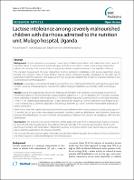| dc.contributor.author | Nyeko, Richard | |
| dc.contributor.author | Kalyesubula, Israel | |
| dc.contributor.author | Mworozi, Edison | |
| dc.contributor.author | Bachou, Hanifa | |
| dc.date.accessioned | 2021-07-27T18:36:55Z | |
| dc.date.available | 2021-07-27T18:36:55Z | |
| dc.date.issued | 2010 | |
| dc.identifier.citation | Nyeko, R., Kalyesubula, I., Mworozi, E., & Bachou, H. (2010). Lactose intolerance among severely malnourished children with diarrhoea admitted to the nutrition unit, Mulago hospital, Uganda. BMC pediatrics, 10(1), 1-9. | en_US |
| dc.identifier.uri | http://www.biomedcentral.com/1471-2431/10/31 | |
| dc.identifier.uri | https://hdl.handle.net/123456789/291 | |
| dc.description.abstract | Background: Lactose intolerance is a common complication of diarrhoea in infants with malnutrition and a cause of
treatment failure. A combination of nutritional injury and infectious insults in severe protein energy malnutrition
reduces the capacity of the intestinal mucosa to produce lactase enzyme necessary for the digestion of lactose.
The standard management of severe malnutrition involves nutritional rehabilitation with lactose-based high energy
formula milk. However, some of these children may be lactose intolerant, possibly contributing to the high rate of
unfavorable treatment outcomes. This study was therefore designed to establish the prevalence of lactose intolerance and
associated factors in this population.
Methods: A descriptive cross sectional study involving 196 severely malnourished children with diarrhoea aged 3-60
months was done in Mwanamugimu Nutrition Unit (MNU), Mulago hospital between October 2006 and February
2007.
Results: During the study period, 196 severely malnourished children with diarrhoea were recruited, 50 (25.5%) of
whom had evidence of lactose intolerance (stool reducing substance ≥ 1 + [0.5%] and stool pH < 5.5) and it occurred
more commonly in children with kwashiorkor 27/75 (36.0%) than marasmic-kwashiorkor 6/25 (24.0%) and marasmus
17/96 (17.7%). Oedematous malnutrition (p = 0.032), perianal skin erosion (p = 0.044), high mean stool frequency (p =
< 0.001) and having ≥2 diarrhoea episodes in the previous 3 months (p = 0.007) were the independent predictors of
lactose intolerance.
Other factors that were significantly associated with lactose intolerance on bi-variate analysis included: young age of 3-
12 months; lack of up to-date immunization; persistent diarrhoea; vomiting; dehydration, and abdominal distension.
Exclusive breastfeeding for less than 4 months and worsening of diarrhoea on initiation of therapeutic milk were the
other factors.
Conclusions: The prevalence of lactose intolerance in this study setting of 25.5% is relatively high. Routine screening
by stool pH and reducing substances should be performed especially in the severely malnourished children with
diarrhoea presenting with oedematous malnutrition, perianal skin erosion, higher mean stool frequency and having
had ≥2 diarrhoea episodes in the previous 3 months.
Use of lactose-free diets such as yoghurt should be considered for children found to have evidence of lactose intolerance
and whose response on standard therapeutic milk formula is poor. | en_US |
| dc.language.iso | en | en_US |
| dc.publisher | BMC Pediatrics | en_US |
| dc.subject | Lactose | en_US |
| dc.subject | Nutrition | en_US |
| dc.subject | Uganda | en_US |
| dc.subject | maltrition | en_US |
| dc.title | Lactose intolerance among severely malnourished children with diarrhoea admitted to the nutrition unit, Mulago hospital, Uganda | en_US |
| dc.type | Article | en_US |

